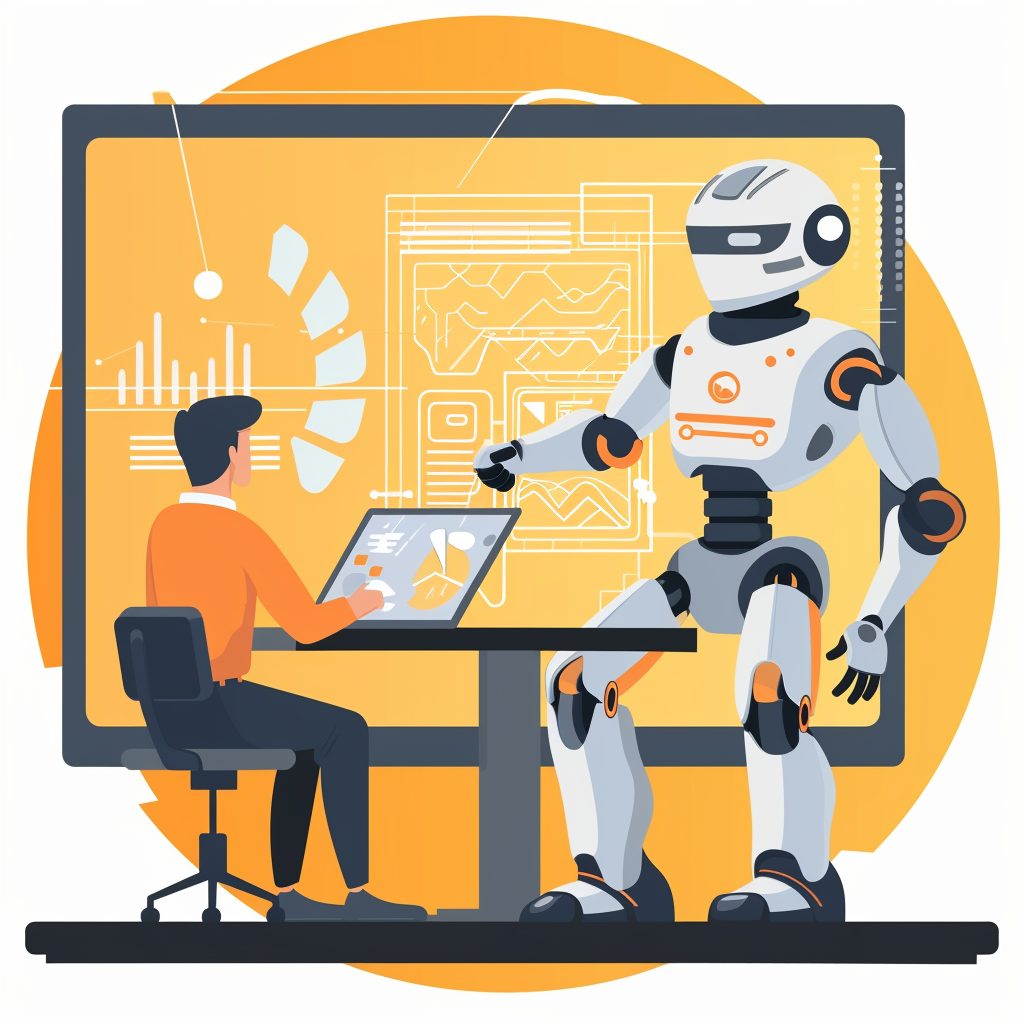Evolution in the Sphere of Web Development
Web development has undergone seismic changes since the inception of the internet. Earlier, creating a website was a tedious task that involved writing hundreds of lines of code. It required specialised knowledge in languages such as HTML, CSS, JavaScript among others. Only those who had a thorough understanding of these languages could efficiently develop fully functional websites. The whole process was tedious, time-consuming, and lacked the modern-day concept of user-friendliness.
Fast-forward to today, the landscape of web development has radically changed. Coding can be greatly simplified through the use of various available platforms and libraries that come with pre-written code snippets for common functionalities. Now, anyone with a basic understanding of these platforms can create visually appealing and interactive websites. The web development sphere has become more dynamic and flexible, thanks largely to technological advancements. Machine learning, Artificial intelligence, deep learning, predictive analysis, and automation have opened up new horizons in web design and development. It’s an exciting era for both web developers and users alike.
Implications of Artificial Intelligence in Website Creation
Artificial Intelligence (AI) has been a driving force in shaping the website creation realm, with numerous applications ranging from design to content generation. Its ability to analyse large datasets and discern patterns has facilitated a more personalised user experience that goes beyond simple user interface customization. Today’s AI-powered content management systems (CMS) can deliver tailored solutions for diverse user groups, leading to higher user satisfaction and engagement.
Simultaneously, AI has introduced automation in the web development process, reducing the time taken to bring a website from concept to completion. AI-driven tools can auto-generate code and suggest design changes, streamlining developers’ work. This level of automation not only eases the burden on web developers but also enhances the final product’s quality by reducing the margin of error. Furthermore, AI chatbots and virtual assistants are emerging as essential components of websites, offering real-time assistance to visitors and enhancing the overall site navigation experience.
Roles Played by Machine Learning in Modern Web Development
The digital domain rapidly evolves, spurred by technological innovations redefining traditional processes and approaches. In this landscape, machine learning has emerged as a significant player, particularly in the context of modern web development. Over the years, machine learning has taken centre stage, offering efficient and highly adaptable solutions to individual business needs. Consequently, machine learning technology can now fulfil several roles to facilitate user-friendly and dynamic web solutions.
One of the most pronounced roles of machine learning in web development involves improving user interface and experience, primarily through personalised content delivery. Machine learning algorithms can analyse vast amounts of data like user behaviours, interactions, and preferences to deliver customised experiences for each user. Furthermore, predictive analytics enabled by machine learning can also help developers by providing insights into future user behaviours. This facilitates the creation of intuitive interfaces and predictive search functionalities, significantly enhancing the overall user experience. Additionally, increased automation driven by machine learning technology allows developers to automate routine and repetitive tasks, boosting productivity and streamlining web development processes.
Emerging Trends in the Age of Digital Transformation
The digital age has significantly reshaped the landscape of web development, with novel trends continually emerging, each showcasing the transformative power of technology. One such trend is the rise of Progressive Web Applications (PWAs), which blend the best characteristics of web and mobile applications. These technologies are a boon for businesses seeking an optimal user experience, enabling the creation of web applications that can function offline and are installable directly from the browser, striking an effective balance between app-like interactivity and the broad accessibility of web pages.
At the same time, integrating chatbots and virtual assistants into websites has become increasingly prevalent. Powered by technologies such as artificial intelligence and machine learning, these tools can mimic human conversation, responding to user queries in real time. As a result, they significantly enhance the end-user’s interaction experience while reducing the response time for customer inquiries. These digital transformation trends pave the way for a more streamlined, efficient, and personalised browsing experience.
How Deep Learning is Shaping Web Development
In the modern digital age, deep learning is steering the course of web development to an unprecedented horizon. With its ability to mimic the human brain, deep learning algorithms are increasingly used to create user-friendly, highly interactive, and personalised web experiences. These applications possess the innate ability to decipher complex patterns, analyse user behaviour, and deliver content tailored to that behaviour, thereby drastically improving the user interface and experience.
Notably, recommendation engines, one of the most prominent applications of deep learning, are used extensively across e-commerce websites. By capturing user data and analyzing past behaviour, these systems provide personalised recommendations, subsequently boosting sales and improving customer satisfaction. Additionally, deep learning is morphing the safety protocols in web development. Intrusion detection systems powered by deep learning algorithms have proven more efficient than traditional methods, effectively fortifying websites against cyber threats. Indeed, deep learning lends a transformative edge to web development.
The Impact of Neural Networks on Website Creation
Neural networks have significantly influenced how website creation unfolds, most importantly by automating complex decision processes and reducing human intervention. As an integral part of Artificial Intelligence (AI), neural networks facilitate pattern recognition and predictive analytics, enhancing user experience and site functionality. These multi-layered algorithms simulate human intellectual behaviour and are adept at handling massive volumes of unstructured data, processing it to discern relationships and patterns humans may fail to identify within a reasonable period.
The advanced trend in personalization, combined with neural networks, has empowered web developers to calibrate websites based on individual user habits and preferences. This not only improves customer engagement but also aids in delivering high-quality, personalised content effectively. With massive dynamic data, rapid changes, and escalating security needs, website development has progressed from static HTML to extensive use of neural networks, deep learning, and machine learning algorithms, aiming to tackle these complexities.
Automation in Web Development through Intelligent Systems
The digital revolution has brought numerous advancements in the tech arena, with web development being one of the major benefactors. Intelligent systems now play a crucial role, automating many processes, thus simplifying the traditionally complex tasks. Tasks such as coding, testing, and deployment, previously reliant on human intervention and expertise, can now be flawlessly executed by these systems. They not only hasten the development process but also eliminate the chances of human error, thereby enhancing overall efficiency and accuracy.
In the context of web design, intelligent systems are instrumental in automating design elements and user interface components. They can learn from user interactions and feedback, giving them a more personalised user experience. The advent of tools providing drag-and-drop functionalities for designing and developing websites illustrates the seamless integration of automation in this sphere. Over time, automation by intelligent systems will continue to disrupt web development, marking a new era of agility and precision.
How Predictive Analysis is Influencing Web Development
Predictive analysis uses statistical techniques leveraging machine learning and artificial intelligence to evaluate the present data and predict future outcomes. In the web development arena, this is gradually becoming an indispensable tool. It is commonly used to analyse customer behaviour in digital environments, optimise user experiences, and estimate potential traffic trends. Thus, developers are allowed to create responsive and intuitive websites that refine the browsing journey for the user.
Moreover, predictive analysis also influences database management, a crucial element in web development. Web developers can predict data growth and estimate adequate storage needs by realising the usual trends and patterns. This helps ensure that future website changes do not compromise speed or performance. Therefore, predictive analysis is not just predicting future outcomes but also putting in place apt solutions today for tomorrow’s potential challenges.
Predictive analysis is influencing web development in several ways:
• Predicting User Behavior: By analyzing past data, predictive analysis can help predict how users interact with a website. This allows developers to create more intuitive and user-friendly interfaces.
• Enhancing User Experience: Through predictive analysis, developers can anticipate the needs and preferences of their users. They can then design websites that cater to these expectations, enhancing user experiences.
• Estimating Traffic Trends: Predictive models allow developers to forecast potential website traffic trends. This helps them prepare for peak times and ensure their sites remain stable even under heavy load.
• Influencing Database Management: Predictive analysis is crucial in database management. It enables web developers to understand trends and patterns to predict data growth and estimate adequate storage needs.
• Preparing for Future Challenges: More than just predicting future outcomes, predictive analysis aids in preparing solutions today for tomorrow’s potential challenges. By understanding what might happen next, businesses are better equipped to plan.
In conclusion, the use of predictive analytics is becoming increasingly important in web development due to its ability to provide valuable insights into user behaviour and future trends. As this technology continues to evolve, we can expect it to play an even bigger role in shaping the digital landscape.
Impacts of Robotics Process Automation on Web Development
Robotics process automation, commonly known as RPA, is a game-changer in web development. It refers to using software bots programmed to undertake tasks previously carried out by humans, such as data entry and form filling, among other mundane tasks. By automating these routine tasks, web development professionals can dedicate more time to complex functions, thereby increasing productivity. This improves the speed of project completion and significantly reduces the chances of human error, contributing to a higher quality of the final product.
The integration of RPA in web development also brings the advantage of round-the-clock operation. Unlike human counterparts, software bots do not need breaks and can work continuously without experiencing fatigue or reduced efficiency. This means businesses can process tasks throughout, ensuring an efficient development cycle. Furthermore, implementing RPA allows for better resource management, significantly minimising web development professionals’ physical and cognitive load. This shift in task allocation has created a more dynamic and high-performance environment in the web development landscape.
Web Development Prospects and Challenges in the AI Era
Integrating Artificial Intelligence (AI) technologies into web development processes has significantly expanded the boundaries and potentials of the field. Sophisticated AI algorithms and machine learning models are now employed in developing intuitive, responsive, and user-focused websites. These advances foster rapid web development, enable customised user experiences, reduce human error, and mitigate repetitive tasks, making the development process smarter and more efficient. Moreover, data-driven predictions and insights made possible by AI contribute to an optimised web strategy, allowing businesses to anticipate user needs and adjust their interfaces and contents accordingly.
However, like any other potentially transformative technology, AI in web development also poses a set of challenges that developers need to tackle. For instance, implementing AI demands a new skill set, which includes a deep understanding of machine learning, deep learning algorithms, and neural networks. Besides, there is always the risk of machine bias, where AI systems copy human prejudices from the data they are trained on, creating potential ethical and legal complications. Additionally, integrating AI technologies into existing or new systems might increase the complexity and cost of projects. In contrast, security and privacy concerns related to AI systems add an extra layer of challenges.










